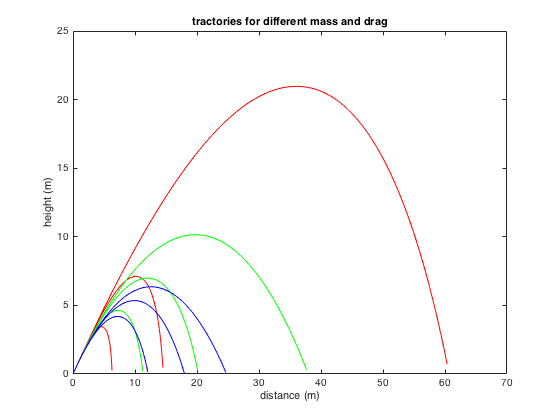An object thrown has two relevant properties: energy, and momentum. When you throw a light and a heavy object "with the same force" (and with this force applied over the same distance), they will have the same energy (energy is Force times distance), but different momentum (Force times time - the heavier object will take longer to throw, and will acquire more momentum).
On the other hand, the heavier object will fly more slowly. Whether it travels further or not depends on which is more important - gravity, or drag.
Case 1: gravity dominates
In the case of a small, heavy object (like a cannon ball), gravity will most likely dominate. In that case, the furthest you can shoot your projectile depends on the velocity and launch angle. If drag is ignored, a launch angle of 45° gets you the most distance, $d = \frac{v^2}{g}$. So if you can throw with twice the velocity, your range increases 4x. This says that if drag is not a factor (for example, on the moon), then you will be able to throw a lighter object further.
Case 2: drag dominates
For objects like Nerf darts, drag scales with the square of the velocity. That means that if you throw something with twice the velocity, it will feel four times more drag. Now momentum is the product of mass and velocity; and we found out above that the heavier object will have more momentum. This leads to the interesting observation that the heavier object will be able to travel further - it is going more slowly, and therefore experiences less drag; and the drag force will have less impact on the velocity that it already has. So even after the light object has slowed down to the velocity of the heavier object, it will continue to slow down more quickly.
Of course in real life, there is a combination of these two factors at play, and you can't solve this problem analytically. But you can solve it numerically. Which I did, just for fun (and illustration).
Taking an object with a diameter of 1 cm (low drag), 5 cm (medium drag), and 20 cm (high drag), and a mass ranging from 20 grams ("light") to 2 kg ("heavy"), I "threw" that object at an angle of 45° with a constant force for 1 meter (unrealistic, but those were the conditions you had stipulated). I did a bit of tweaking of that force, figuring that the range of a 150 g object should be below 100 m (the maximum pitch of a 145 g baseball is 132 yards). Then I plotted the resulting trajectories:

Here the red traces correspond to a mass of 50 g, green = 150 g, blue = 250 g; and the three curves correspond to a diameter of 5 cm, 15 cm, and 25 cm. As you can see, one of the red curves (corresponding to lightest object, smallest diameter) goes furthest; but as we add more drag (diameter), it quickly falls back in the standing. By comparison, the small heavier objects don't fly as far; but as drag becomes more important, they "win".
The following MATLAB code was used to generate the trajectories:
function [x, y, range] = trajectory(v, angle, mass, diameter)
C=0.5;
rho=1.2;
g = 9.81;
A = pi*diameter^2/4;
v0=v*sin(angle);
% terminal velocity equations from
% http://hyperphysics.phy-astr.gsu.edu/hbase/Mechanics/quadrag.html
vt = sqrt(2*mass*g/(C*rho*A));
tau = vt/g;
tpeak = tau*atan(v*sin(angle)/vt);
ypeak=-vt*tau*log(cos(atan(v0/vt)));
tdown = tau*acosh(exp(ypeak/(vt*tau)));
NT=200;
% we want "enough" time; this should usually do it
% given that we don't have an analytical expression for how horizontal
% component of velocity affects the vertical time
% but we know that if there is a lot of horizontal component, it will
% quickly disappear...
tmax = 2*(tpeak+tdown);
T = linspace(0, 2*(tpeak+tdown), NT);
x=zeros(1,NT);
y=zeros(1,NT);
vx=zeros(1,NT);
vy=zeros(1,NT);
vx(1) = v*cos(angle);
vy(1) = v*sin(angle);
theta=zeros(1,NT);
theta(1)=angle;
dt = T(2)-T(1);
for ti = 1:NT-1
V2 = vx(ti)^2 + vy(ti)^2;
F = 0.5*rho*V2*A*C;
Fx = -F*cos(theta(ti))*sign(vx(ti));
Fy = -F*sin(theta(ti))*sign(vy(ti)) -mass*g;
vx(ti+1) = vx(ti) + Fx*dt/mass;
vy(ti+1) = vy(ti) + Fy*dt/mass;
theta(ti+1) = atan2(vy(ti+1),vx(ti+1));
x(ti+1) = x(ti)+0.5*(vx(ti)+vx(ti+1))*dt;
y(ti+1) = y(ti)+0.5*(vy(ti)+vy(ti+1))*dt;
if y(ti+1)<0, break; end
end
if(ti<NT-1)
range = x(ti) + y(ti)*(x(ti+1)-x(ti))/(y(ti)-y(ti+1));
else
range = x(end);
end
x=x(1:ti); y=y(1:ti);
And plotting the trajectories was done with:
figure
colors = {'r','g','b'};
ci=0;
for m=[0.05, 0.15, 0.25]
ci=ci+1;
for diam = [0.05, 0.15, 0.25]
% constant force = constant energy
% velocity scales with inverse square root of mass
% scale factor is chosen to get "sensible" distances
sf = 8;
v = sf/sqrt(m);
[x,y,r]=trajectory(v, pi/4, m, diam);
plot(x,y,colors{ci})
hold on
end
end
xlabel 'distance (m)'
ylabel 'height (m)'
title 'tractories for different mass and drag'

